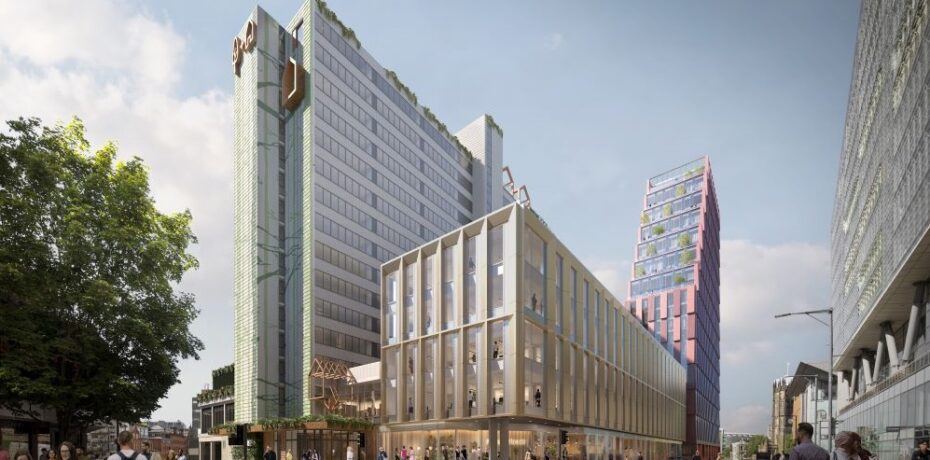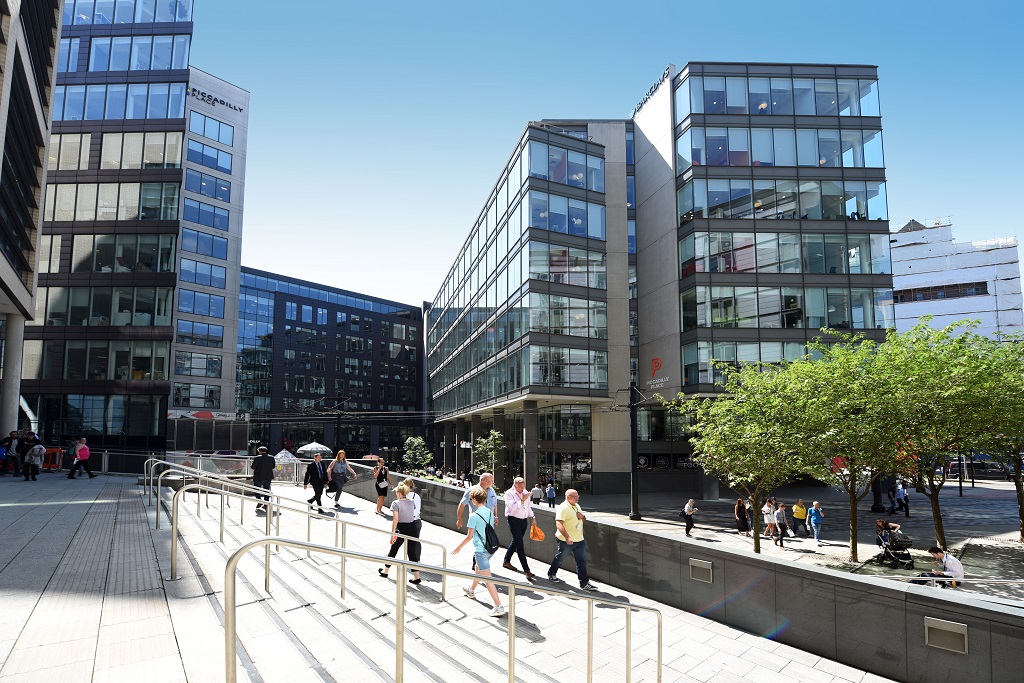The Subplot
The Subplot | Levitating office market, culture, London’s billions
Welcome to The Subplot, your regular slice of commentary on the business and property market from across the North of England.
THIS WEEK
- The North’s amazing, levitating office market: what goes up doesn’t come down
- Elevator pitch: your rundown of what is going up and down this week
BEHOLD, A LEVITATING OFFICE MARKET
What goes up, doesn’t come down?
The major UK regional office markets – with Manchester and Leeds to the fore – seem to be defying economic gravity.
Got the midwinter blues? Depressed by economic data showing slow growth and insolvencies soaring? The North’s major office markets certainly aren’t. Take-up is strong, rents are up, optimism abounds. How can this be, given that the economy appears to be crumbling? Starwood Capital and Property Alliance Group chose miserable January to press on with a 50,000 sq ft new-build in Deansgate, and they are not alone.
Good numbers
The past 12 months felt like a return to the old normal, and the last quarter was impressive. Manchester city centre recorded 1.2m sq ft of deals, with 427,000 sq ft secured in the final three months. This is within spitting distance of the pre-pandemic total of 1.45m sq ft signed in 2019. Leeds Office Agents Forum data shows city centre take-up of 618,000 sq ft, on a par with 2021 thanks to a particularly strong Q4 which totalled 210,000 sq ft.
Funny maths
And yet there’s an underlying sense that something doesn’t add up. We know the economy is in trouble – the only issue is how long and how deep the trouble will be. We can see rising inflation and interest rates will stay high well into 2024. So surely occupiers ought to be reining in their galloping demand for new smart offices? One city agent reported a phone conversation with a vast regional landlord last week. His summary: “We were saying, look, the occupier side is good, but we really don’t understand why.”
Blip blip
There are several potential explanations, some more happy-making than others. The most obvious is that the last three or four months of 2022 saw the sudden conclusion of a slug of pent-up demand for fancy workspace. Now those deals are done, that’s it, the market is closed until the economic green shoots start appearing in 2024.
Don’t worry, be happy
The hard-core optimists (who think they are realists) do not buy this, not for one minute. “It’s not a blip,” says Knight Frank’s David Porter, who thinks the Q4 performance was thanks to a few summer deals landing late. John Nash at Manchester’s Canning O’Neill says: “If it was all doom and gloom then we wouldn’t be seeing Deloitte taking over 60,000 sq ft or businesses like Peak moving to over 35,000 sq ft or Cloud Imperium Games expanding already. Any other regional city would rightly be shouting from the rooftops about deals like those.”
Lots to shout about
Will the market continue to roll? Reasons to suppose it might include serious known requirements which, while scarcely a tsunami, amount to at least a nice healthy splash in the ocean. In Manchester, there’s a generous 500,000 sq ft of live, serious deals with names like BDO and Pinsent Masons in the frame. In Leeds, there is fighting talk of 245,000 sq ft let at MEPC’s 11-12 Wellington Place, and equally good vibes about deals at McAleer & Rushe’s 138,000 sq ft City Square House.
Lease events are happy events
Completing this list of almost-in-the-bag deals won’t exhaust demand. Knight Frank suggests there’s plenty more to look forward to as longer-term office deals agreed in the post-Great Financial Crash era reach maturity. In Leeds, around 1.7m sq ft of lease events are due in the next two years, but the supply pipeline is just 487,000 sq ft. In Manchester, it’s 2.8m sq ft and 692,000 sq ft. These are very encouraging numbers to drive development.
But inflation
On the other hand, rising prime office rents – generally celebrated by agents and developers as a sign of success – might suggest the opposite. Rents are high because of the low supply of the modern whizz-bang floorspace occupiers have convinced themselves they need. At the same time these businesses – survivors of the pandemic – are generally flush with cash. When lots of money means not much to spend it on, prices rise (hello inflation, my old friend). It looks likely that the supply of new Grade A office floorspace is going to stay low (see below).
Up, up and away
This improves prospects that even modest demand will keep rents afloat, and will probably push rents up. In Leeds, under-rented compared to Manchester, Birmingham, and Bristol, this is likely to be conspicuous. “Leeds rents have risen from £34.50 to £36, and I wouldn’t disagree with those who suggest we’re heading to £38/sq ft by the end of the year. Leeds is still at a discount to the other big six regional markets where everyone else is nudging £40/sq ft,” says Colliers director Roddy Morrison.
How high can you go?
The difficulty is that if they go much higher, even the most choosy occupier’s FD will begin to ask questions. The property industry’s perennial bleat that real estate costs are just a tiny fraction of overall occupier spend, and thus rental movements only matter at the margins, could lose its appeal. If the UK economy has turned into a bin fire it definitely will.
And here’s the answer
CoStar data, shared with Subplot, suggests Manchester is in for a slightly bumpier ride. CoStar predicts net absorption remaining positive in 2023 (465,000 sq ft in the central business district), although not at 2022 levels (759,000 sq ft) until 2025. The trend vacancy rate will stick at 11-12% throughout, a big change from the 7-9% of the recent past.
Money talks…
What goes up must come down, and it can’t levitate forever. Investors know this. The volume of investment in UK office real estate has taken a mighty tumble in the last year – and it was especially sharp in the final quarter. Leeds office investment volumes in 2022 were down 37%, with yields bouncing up by 50 basis points, and in Manchester it was 37% and 100 basis points (Knight Frank data). LSH came to the same conclusions, and it’s grim reading. Investors are generally the first to smell a fox. Perhaps it is time for bushy-tailed agents to heed the warning?
…and walks
And yet even here in the cold hard world of investment, there’s some reason for hope.
Allsop’s Dale Johnstone says international money is on the way back. “There’s a lot of global capital waiting, not being quite brave enough yet after the bruising from Truss. They want to do deals but there is still a pricing gap.” Johnstone is talking to Middle Eastern clients who want to get spending, and reckons there’s some tasty higher yielding options in the regions that will definitely bring them back to the table. “Fifteen year lease, 7% yield, smaller lot size £20m or so – that typifies what they are after,” he says.
For now the office market in Manchester, Leeds, and other locations with heft continues to float above the looming economic distress. Nobody knows how long this feat of prestidigitation can last.
 ELEVATOR PITCH
ELEVATOR PITCH
Could London’s unspent office investment billions head to Manchester offices? And what of the economic impact of big flashy cultural developments? Doors closing, going up!
 Office hopes
Office hopes
Investors took a cool view of Manchester office property in 2022 (see above). But if a little of the flood of overseas money coming to London this year gets diverted north, 2023 could be very different. Knight Frank guestimates that £9.5bn is heading into the London office market this year, about a quarter from super-rich individuals and families. A little less than half will come from the Asia Pacific region.
Knight Frank says there are about four pounds worth of potential spending chasing every deal, so there’s £44bn looking for somewhere to go – and why not head north for lower yields and a bit less competition? The fly in the ointment is Manchester’s relatively high vacancy rate compared to the West End where it is 5%. But many will think this a modest risk worth taking.
Kulchur
Key Cities – the national network including Blackpool, Doncaster, Lancaster, Salford, Hull, and Bradford – says there needs to be “a more inclusive approach to stimulating the economy and highlighting a link between low cultural engagement and deprivation.”
The group’s Culture and Place in Britain report shows a clear correlation between cities with a limited cultural offer and higher socio-economic deprivation. It recommends a £100m investment in creative industry microclusters to spread economic growth and opportunity more evenly around the country.
If there’s a problem here it is that £100m isn’t going to buy much. Serious infrastructure – as opposed to the odd pop-up event or training session – costs serious money. Manchester’s Factory arts centre was an outlier at £211m, but Prescot’s Shakespeare North complex cost £31m. Much can be done without real estate, but much good will simply evaporate without it.
Get in touch with Place North West news@placenorthwest.co.uk





Not been in the Office world for a while but i’d guess a lot of the stock making up the 11/12% vacancy rate won’t be fit for purpose with substantial barriers in terms of cap ex so the real vacancy rates will be lower which will still support rental growth in the medium term for good quality buildings. Take a look at how fast the city centre is growing driven by a younger demographic who want something very different from the workplace.
By Steve
Agreed with Steve’s comment. Additionally, a few old office blocks may be on the pipeline to wait for the redevelopment. These certainly will drive up vacancy number a little bit.
By Anonymous